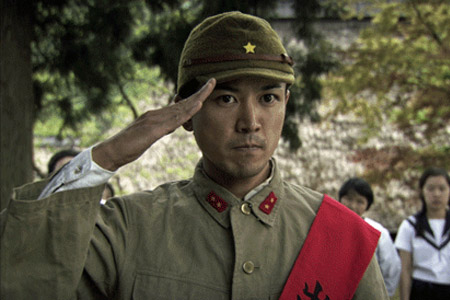WARNING: This video contains explicit sexual and violent content and is intended for mature audiences. Parental discretion is advised.

Koji Wakamatsu—known as the Godfather of the pink movie, a genre of Japanese softcore exploitation films that started in the 1960s—has made over 100 movies, and is enjoying the most acclaimed period of his career thanks to two recent films that have much more on their mind than sex. Both films, United Red Army (2007) and Caterpillar (2010), are available on Fandor. This video essay explores how these films amount to hardcore history lessons: Wakamatsu uses low-budget exploitation filmmaking techniques to cast a critical eye on Japanese history during periods of prevailing militant ideology, as well as a brutally honest assessment of human nature.
[iframe src=”http://player.vimeo.com/video/39860072?title=0&byline=0&portrait=0&color=ffffff” width=”600″ height=”381″ frameborder=”0″ webkitAllowFullScreen mozallowfullscreen allowFullScreen]
TRANSCRIPT:
Koji Wakamatsu is known as the Godfather of the pink movie, a genre of Japanese softcore exploitation films that started in the 1960s. Wakamatsu made his name with these films, directing dozens of them over the past five decades. Now in his 70s, Wakamatsu has made over 100 movies, and is enjoying the most acclaimed period of his career thanks to two recent films that have much more on their mind than sex.
The first, United Red Army, shows the rise and fall of a militant radical left-wing organization with which Wakamatsu was involved in the ’60s and ’70s. Shot on digital video, the low-budget style of film is spare and unglamorous, but direct and forceful, and it catches you in its historic sweep. Nothing short of an epic, United Red Army is an intensely personal film for Wakamatsu. He spent one million dollars of his own money and mortgaged two of his houses, destroying one of them in order to depict the violent showdown between URA soldiers and the police.
Wakamatsu did all this in order to tell the story of the URA in a way he considered truthful. But he doesn’t romanticize their struggle. Instead he shows with brutal frankness how their radical idealism morphed into a cult of psychological and physical punishment with murderous results. Unlike Wakamatsu’s past films, there is just one instance of nudity, and it is anything but erotic. A URA member has been tortured to death by her own comrades, and another is forced to bury her as her own punishment for being too feminine and weak. It’s part of a long, masterful sequence in which group tears itself apart by taking its ideology to terrible extremes. It plays like a horror movie, one that’s all the more horrifying because it actually happened.
In Wakamatsu’s next film Caterpillar, he takes on another militant chapter of Japanese history. It is World War II: a Japanese soldier is seen raping Chinese women, then he is seriously wounded and returns home without arms or legs. His village hails him as a hero, a war god. His wife must carry out her duty in service to him, tending to him, feeding him, and satisfying his sexual urges. These scenes are more disturbing than erotic, but Wakamatsu delivers them in his typical no-nonsense manner, with a sense of honesty that sticks you in the gut.
And just when you think that it’s a story of a victimized woman suffering in a sexist militaristic culture, he turns the tables. The wife carts her husband around the village, elevating her status among the villagers as a model wife, while humiliating her husband in his pathetic state. As in United Red Army, we see how a hardline militaristic environment breeds monstrous behavior. Victims become villains, and vice versa. Eventually the evil soldier’s war crimes catch up with him in the midst of sexual pleasure. And somehow, the impossible happens. We actually feel sympathy for this monster, or at least we come to recognize his humanity, both his selfishness and his suffering. This is Wakamatsu’s way of looking at people, resisting idealism, beauty, even humanism. Instead he sees people for who they are: products of the world they find themselves in, doing what they can to get through it.



